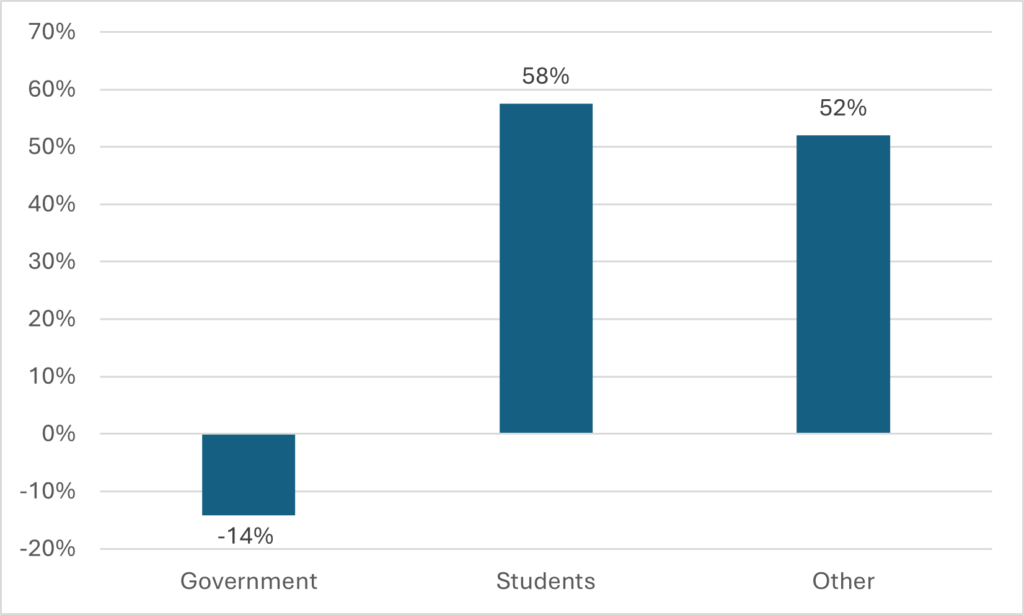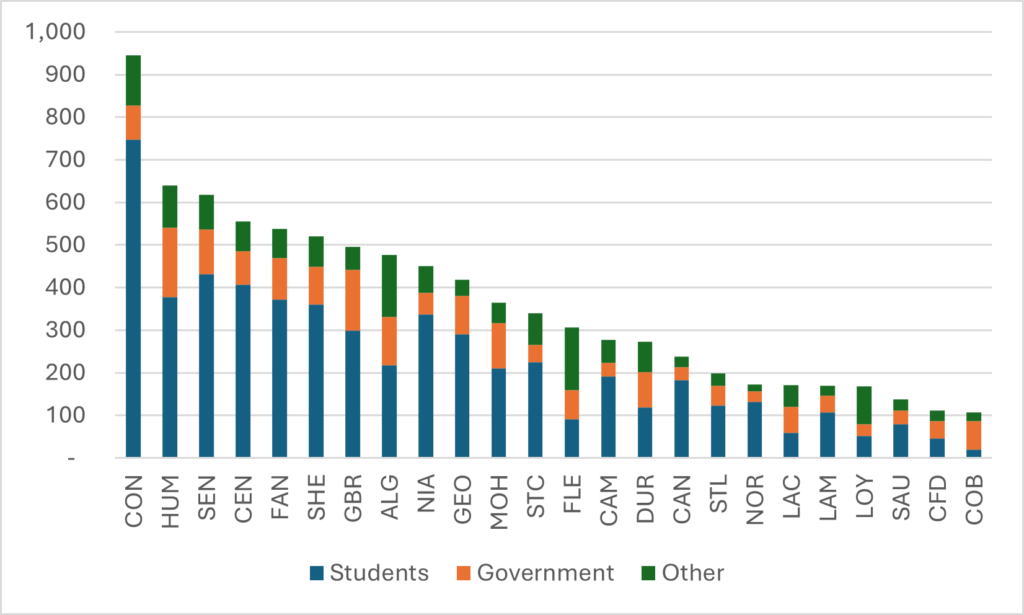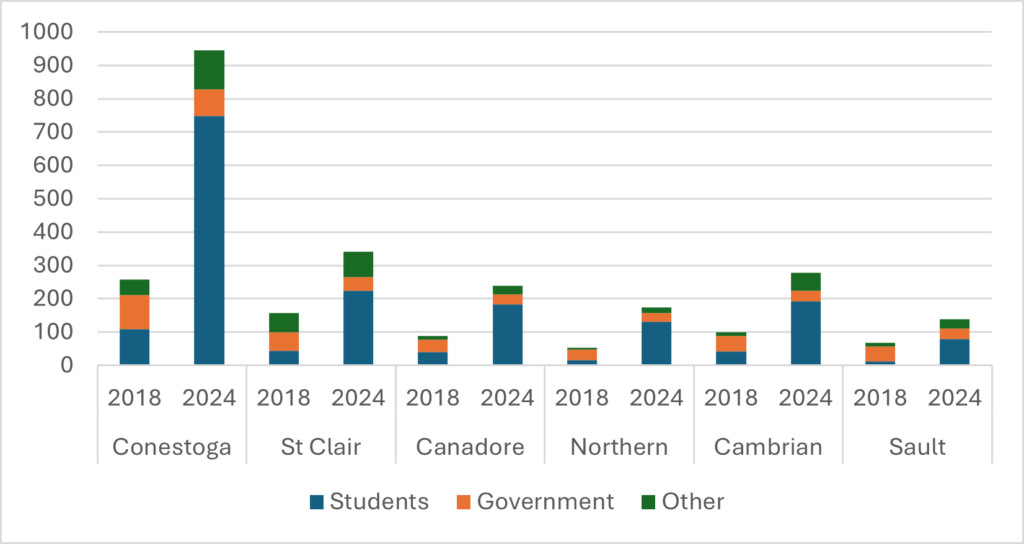Over the summer some of the HESA team went through the financial statements of the 24 Ontario Community Colleges for both 2022-2023 and 2023-24 statements. It’s…well, pretty wild.
Ontario colleges were going after international students pretty heavily before COVID. But in the two years since the pandemic mostly subsided, the numbers are crazy. We don’t know exactly how crazy because the Government of Ontario, in an amazing show of either incompetence or gutlessness, is now five months late in releasing institutional enrolment data for 2023, and has chosen not to respond to a very polite inquiry about a possible release date from yours truly back in early July (the service standard for responding to inquiries is allegedly 15 days). But boy can we see the change in institutional finances.
Figure 1 shows the two-year change in income by source, from 2021-22 to 2023-24. Income from the federal and provincial governments (mainly the latter), fell by about 14% after inflation between 2021-22 and 2023-24. But this was more than offset by gains in income from two other sources: students (that is, through tuition fees, overwhelmingly from international students) and “other”—that is, various forms of self-generated income.
Figure 1: Change in Real Total Income by Source, Ontario Colleges, 2021-22 to 2023-24, in Constant $2023

This is of course just another installment in a long-running line of hits entitled: “How Ontario Colleges Became Financial Juggernauts.” Figure 2 shows total income by source for all Ontario colleges, in real $2023, going back to 2017-18. What it shows is that after inflation, over five years the sector’s tuition revenues rose by 150% and its total income by 65%. FTE student numbers also grew of course, but only by about 5% (at least up until 2022-23, we still don’t know about 23-24 due to the aforementioned incompetence/gutlessness) meaning that per-student income has likely risen by about 57% over this period.
Figure 2: Total Income by Source, Ontario Colleges, 2017-18 to 2023-24 in Billions of Constant $2023

Let me point out two things here.
First, with the possible exception of Australia, there is really no other college or college-equivalent sector in the western world like this. In every other part of the world, the non-university post-secondary sector is based around principles of access and affordability. It would be inconceivable anywhere else for such a sub-university sector to get 64% of its revenues from tuition fees, the way Ontario does.
Second, there is no national or sub-national post-secondary sector in the world where total revenues have jumped by 55-60% per student in the last six years. None. Zero. Nada. The narrative you hear sometimes about international student income being needed to offset government cutbacks…it’s true in some provinces and in some sectors. But not the Ontario college sector. Sure, income from governments is down about 17% in real dollars over these six years. But overall, college income is way, way, way up.
Look at Figure 2 again. Quite clearly, in 2022-23, colleges as a whole were doing pretty well. College leaders could have looked at the huge growth to date and said to themselves: “we are absolutely satisfied with what we have, we don’t need any more growth.” But as a sector (there were a couple of honourable exceptions), they simply said “damn the torpedoes” and tried to grab another $1.3 billion in revenue on the assumption that minting money via international students was an exercise that could go on ad infinitum.
We know how that turned out.
Figure 3 shows college income by source for individual colleges in Ontario for 2023-24. Out of 24 colleges, only the two francophone colleges—La Cité and Collège Boréale—received more money from government than they did from students.
This is not normal.
Figure 3: Total Income by College and Source, Ontario, 2023-24 in Millions

We can also look at a few institutions to see which have seen the biggest changes over the past six years. Six institutions saw their student fee income increase by a factor of four or more in real dollars between 2017-8 and 2023-4: Northern (x8.11), Conestoga (x6.74), Sault, (6.37), St Clair (x 4.97), Canadore (x4.54), and Cambrian (x4.49). Figure 4 shows how radically these increases transformed the fabric of the institutions. Northern went from an institution generating $54 million a year (in $2023) to one which generates $173 million a year; Conestoga went from a $265-million/year ($2023) operation to one generating nearly $950 million per year.
Figure 4: Total Income by Source, Selected Ontario Colleges, 2017-18 vs. 2023-24 in Millions of Constant $2023

Of course, this extra income doesn’t go straight to the bottom line: much of that new money is going to meet higher expenses involved with teaching more students, either directly or through fees paid to private colleges in PPP arrangements. Figure 5 shows the net surplus for each institution plus the provincial system as a whole for both 2017-18 and 2023-24. In 2017-18, the system as a whole made a surplus of about $226 million (in $2023) on revenues of $5.26 billion. In 2022-23, the system had a surplus of over a billion dollars on revenues of about $8.7 billion. In both years, 23 out of 24 colleges posted a surplus. But the size of the surpluses were completely different: 13% system-wide in 2023-24 vs just 4% six years earlier. 23 out of 24 colleges had better net results in 2023-24 than in 2017-18, the exception being Mohawk College. And some of these surpluses were truly staggering. At Conestoga, revenues exceeded expenses by 36% in 2023-24 and in absolute terms the surplus was almost exactly the size of entire budget six years earlier. At La Cité, the net surplus was 32%, the second year in a row it exceeded 30%, while at Northern and Lambton, the surpluses were 24% and 21%, respectively.
Figure 5: Net Surpluses as a Percentage of Total Expenditures, Ontario Colleges, 2017-18 vs 2023-24

All in all a remarkable story, one with very few parallels anywhere in the world of higher education. Even more remarkable was that it was the federal government, rather than the provincial one, that had to put a brake on all this.

 Tweet this post
Tweet this post

Given the flimsy foundation for so many of the colleges’ revenue streams, new federal caps, and in the face of continued public hostility to more international visas, sector-wide collapse feels possible. Or at least major consolidation.
That said, I wonder if there’s a path between the unregulated approach that led to Conestoga amassing a surplus bigger than the sector-wide surplus from five years earlier, and total collapse.
What about something like the federal government indexing international visa permit numbers by province against the province’s funding for domestic students? The less a province pays into their system, the more international visas are permitted. This could put pressure on provincial legislatures to pony up the funds if the public wants to see fewer international students in their communities.
Back on the eleventh you wrote the following:
If there is one thing that drives me nuts, it is people within the higher education system who tut-tut about their university having taken “too many risks” and becoming “too dependent” on international student revenue.
How would you feel about people saying this about colleges in Ontario?
When we look at healthcare in this province, and when you look at the crumbling infrastructure at some of the colleges in Ontario, I think a surplus was needed to ensure Ford’s lack of funding didn’t ruin them. The Northern or secluded colleges needed this or else their campuses would be stuck in the past. Has Ford’s investment in higher ed kept up with inflation? The ones running Conestoga have done a disgusting job and ruined the sector and an entire city, they should not be given any study permits until the city is happy with the number of jobs and housing available. There should be better regulation on P3s, is there any? There are too many of them that are run in tiny strip malls – that money is going to investors or into services?! Are P3s signing any agreements to provide housing? Are the services on offer staffed correctly?
Can you make your dataset public? It would be amazing to be able to browse the different college financial statements in one place…
Honestly, I am appalled. No post-secondary institution (looking at you, Conestoga) or system (Ontario colleges as a collective) should be allowed to independently reshape a nation’s demographic makeup in just a few short years. Why on earth didn’t the Boards step in and put a stop to this? Didn’t any Board Chair take a step back and say, “are we sure this is a good thing for the community, province and country?” Didn’t any of them read David Trick’s 2017 report, which clearly warned the sector about the fire they were playing with? Or did they read it but just not care? I’ve a feeling the Feds are not yet finished trying to clean up the mess, and fully expect Ontario colleges to face even tighter visa restrictions in the future.
Not only did the board not intervene Conestoga’s case, they openly rewarded John Tibbits and his no-holds-barred expansion plan with a contract renewal earlier this year. This in spite of the ongoing public relations nightmare that’s created every time he speaks in public. The public deserves better from Conestoga’s Board.